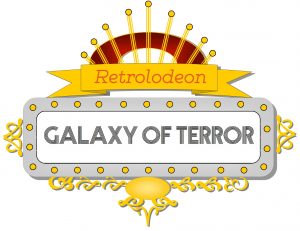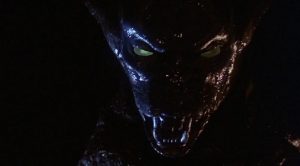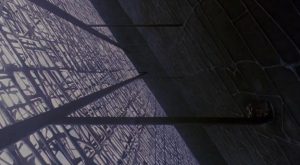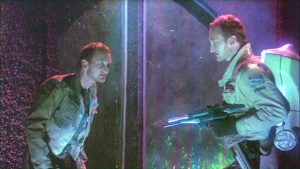
It’s not so much a galaxy of terror as it is a planet of one. Morganthus, to be precise. A planet filled with terrors indeed, all the result of the victim’s subconscious. The spaceship Quest embarks on this planet in a rescue mission, finding only dead bodies to retrieve. Seeing as how they didn’t bring body bags, the crew simply disintegrates the corpses with laser-powered flamethrowers. Nifty! These don’t work so well against the creatures of the night, which prey on their victims’ worst fears. The crew must find an escape following their crash landing (how convenient) or else become another corpse to disintegrate.
That’s the short and skinny of “Galaxy of Terror,” an often-times arbitrary but nevertheless entertaining sci-fi cheapie from producer Roger Corman. Why B.D. Clark, who directed and co-wrote the film alongside Marc Siegler, felt the need to specify the creatures as nightmarish figments of one’s imagination is beyond me. Certainly the target demographic would’ve accepted a planet filled with abnormal beasts that dine on human flesh. I presume the reasoning is to heighten the suspense, extracting drama from each character’s fears. That way when the conquering hero prevails, he’s not only defeating the antagonist but his personal demons, as well. Too bad the characterizations are reduced to cheap exposition dumps that leave a lot of questions unanswered. I need not know that two crew members were old college rivals, as that barely plays into their fears (if it is one of inadequacy, it got lost in the shuffle). Each conflict being resolved almost immediately thanks to the hyper pacing doesn’t help matters.

Films like “Galaxy of Terror” don’t live and die on logic, though. They succeed in being special effects extravaganzas; popcorn entertainment for the least demanding. I don’t mean this to be insulting, as I’m proudly a member of that group! While I love and praise thought-provoking cinema, my bread-and-butter lies in cheesy cinema. I grew up a lover of monster movies and mindless action spectacles and not much has changed. Yes, my taste has diversified, but B-movies still bring me unabashed joy. I’m happy to report that “Galaxy of Terror” brought me such joy!
Excusing the needlessly convoluted plot elements allowed me to enjoy the finer elements of “Galaxy of Terror,” such as the surprisingly stellar special effects! Oh sure, the low budget seeps through at times, be it the hokey lasers or the spaceship interior that occasionally resembles lunch trays bolted to the walls. Amidst the cornier effects are astonishing ones, such as the terrifyingly realistic melting bodies and the larger than life creatures that ooze slime and never-ending tentacles. Even Jacques Haitkin’s cinematography is grander than expected, getting great scope out of the set design. A kaleidoscopic bridge looms over the crew, the lighting elongating their shadows as they cross. A triangular gate to another dimension looms in the background, intoxicating to the viewers and characters.

If there is anything to be praised about the erratic nature of the planet, it’s that the self-inflicted fears bring about a nice variety. The film isn’t the “Alien” rip-off it sells itself as (the tagline is “ALIEN was the beginning … Hell Has Just Been Relocated!,” after all), avoiding becoming a repetitive of slog of creature attacks. One crew member, Quuhod (Sid Haig), has his weapon of choice turned against him as he battles his claustrophobia. Another, Ranger (Robert Englund), fights a clone of himself, his biggest fear being himself. Both of these fears raise their own questions (why does Quuhod fear his own weapons turning against him and why does Ranger fear himself?), but provide a welcome break from the norm. The former even has one of the more gruesome effects, as one of Quuhod’s crystal throwing stars slips into his skin. The end result is him lobbing his own arm off with one fell swoop, followed by his disembodied arm chucking the throwing star into his heart. I never said the film was logical.
The creatures themselves bring about wonderfully demented scenarios, as well. The infamous sequence from this film is the worm sex scene, in which a gigantic worm that sprouts tentacles rapes Dameia (Taafe O’Connell). Because who doesn’t ultimately fear a gigantic worm raping them to death? It’s not so much graphic as it is comical; O’Connell flailing about underneath a giant worm as slime drips on her. It is uncomfortable, to say the least, though I suspect it elicits a lot of laughter too. It’s bizarre enough to stand out from the pack, which a film like “Galaxy of Terror” thrives on.

There are many moments of laughter in “Galaxy of Terror,” some at the expense of the film. It’s hard not to laugh at the hypnosis being represented by a flashing red orb upon the face of the mediator. The same goes for the ridiculous explanation for the planet’s power, which would’ve went best unanswered. And yet, amidst the flaws is a campy delight. One that moves smoothly, the eighty-minute runtime moving by briskly. This is a burden at times, rushing the drama and suspense instead of allowing it to fester, but it never drags. Even when laughing at the film, I was thoroughly enjoying it. For a film like this, that’s mission accomplished.
P.S. The film’s production designer and second unit director was James Cameron, one of his earliest projects. Even if this is a film you despise, it stands the test of time as giving a titan in the industry an opportunity to shine.
Final Rating: B
